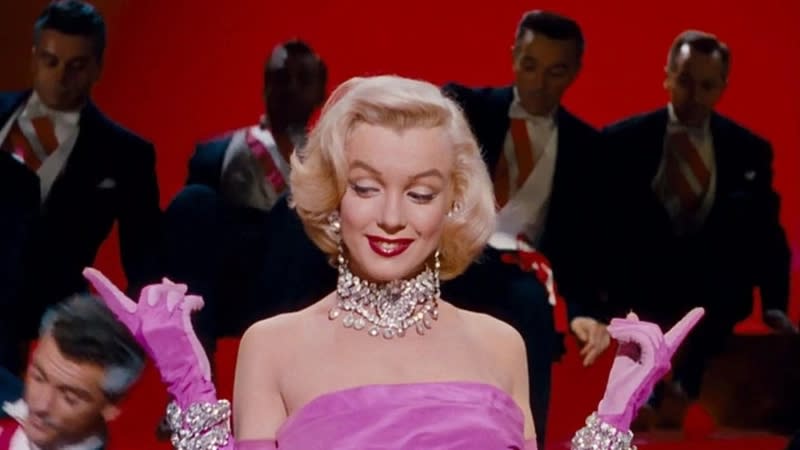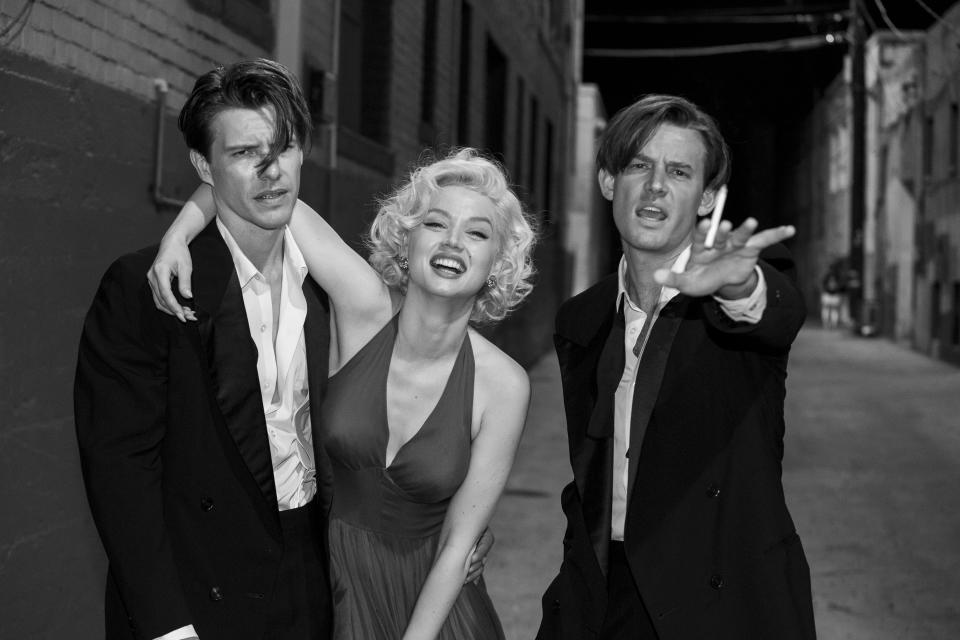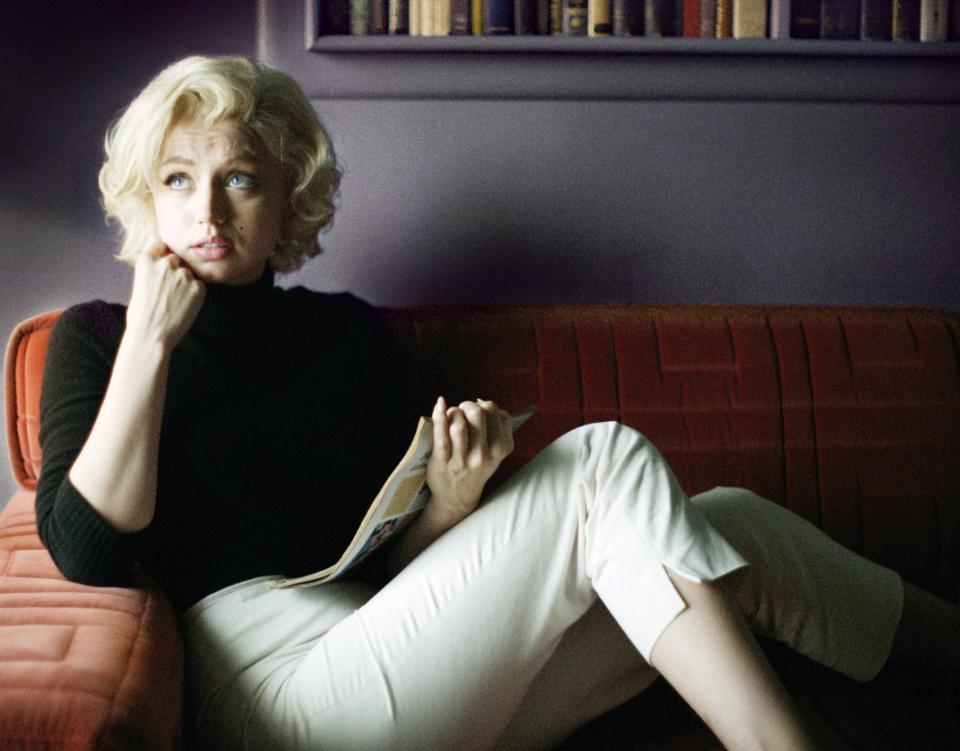Just How Miserable Is ‘Blonde’ Supposed to Make Audiences?

- Oops!Something went wrong.Please try again later.
- Oops!Something went wrong.Please try again later.
“Blonde” has been making a lot of noise in recent weeks. Director Andrew Dominik’s long-gestating adaptation of Joyce Carol Oates’ novel revisits Marilyn Monroe’s career through the prism of the abuse that followed her throughout her career. Dominik’s loose approach to his subject and the movie’s many disturbing twists have generated a lot of fierce debate, even as Ana de Armas’ performance as Marilyn has been celebrated.
With “Blonde” out on Netflix this week, IndieWire executive editors Eric Kohn and Kate Erbland, plus chief film critic David Ehrlich, swapped thoughts on Dominik’s divisive undertaking via email. So, just how miserable is “Blonde” supposed to make its audience? Does it succeed? And what’s the point?
More from IndieWire
How 'Entergalactic' Pictured the Love Story in Kid Cudi's Head (and Songs)
Greta Gerwig Knows 'White Noise' Sounds Like the Ramblings of a 'Stoned Teenager'
ERIC KOHN: Here’s a thought experiment for you: Imagine a movie about a fictional star in the 1950s and ’60s. After navigating a troubled childhood, she makes her way through the worst of Hollywood’s misogynistic empire — including the proverbial “casting couch,” of course — to become a big-screen icon. Even as her star rises, she’s further objectified by everyone around her. Her audience grows but her world shrinks. It’s a grim meditation the severe hardships of classic Hollywood fame, and made with an ironic use of the same style as the films she stars in. It’s such a vivid tale of woe it almost seems like it’s based on a true story.
Of course, that movie exists, and it’s “Blonde.” It may not be fictional to the bone, but it sure feels that way.
Director Andrew Dominik’s dreary take on Marilyn Monroe was maligned before most people had a chance to see it, and even the occasional positive take on the movie’s dreamlike descent into the existential horror of its subject’s existence can’t overcome the overarching sense that Dominik’s subjective look at Monroe’s struggles deprives viewers of the pleasure associated with her career. Yes, he’s adapting Joyce Carol Oates’ invented take on the actress, but that context doesn’t disabuse from the movie from the odd way it regards Monroe as a creature of pure misery, as if the most beleaguered people weren’t capable of experiencing much joy — or conveying it, as she did onscreen.
In a widely-circulated interview with Sight & Sound, Dominik pushed back on the notion that Monroe’s acting talent was worthy of celebration. He even maligned “Gentlemen Prefer Blondes” as a movie about “well-dressed whores,” a horrible reduction of that delightful experience even if it was intended to criticize the way the work comes across.

Everett
But we aren’t here to determine whether Dominik is the appropriate vessel for assessing his movie. We’re here to sort out “Blonde,” a movie that bears such little resemblance to anything in the pantheon of Monroe’s work it may as well hail from a “Twin Peaks”-style alternate universe. And in fact, there’s a certain Lynchian vibe that Dominik pulls off here, simply because he’s an extraordinary visual stylist and mood poet (see: “The Assassination of Jesse James,” and see it on a big screen if you can). I was entranced by early color scenes of Monroe’s childhood, as her mother drives the young girl into a fire that seems as if it’s emanating from the gates of hell; likewise, Dominik’s ability to play with screens-within-screens at critical moments magnifies the sense that Monroe was forced to put on a show even when the cameras weren’t watching. Then again, it’s awfully heavy-handed in the way it makes that point, over and over again, twisting the blade to an extent that border on masochism.
Of course, maybe that’s the point as well: “Blonde” doesn’t just show us how Monroe was objectified; it dares to play a role in that process.
All of which is to say that I have very complicated feelings about this problematic movie. It’s loaded with ambitious filmmaking tactics that enforce a new perspective on Hollywood lore. At times I found it to be a noble failure. Elsewhere I found it appalling, and at worst, weighed down by bizarre miscalculations (yes, those fetus shots are inane). Even then, though, I was entranced by Ana de Armas.
As Monroe, de Armas is such an extraordinary screen presence that often overtakes the movie’s flaws. She devolves into caricature. It’s unfortunate that the discourse surrounding “Blonde” obscures such an elegant, layered performance, because it injects a degree of authenticity into the movie that saves it from collapse on more than one occasion. I don’t think she deserved a different kind of vehicle for this performance, either. We have so many previous iterations of Marilyn Monroe in more traditional movies that her interpretation actually benefits from the unorthodox approach. It’s a meta movie with a meta performance that she inhabits with utter credibility. Watching her, you can see how she’s working through the innate problem of representing Monroe when most of what he have left of her legacy is based on a degree of remove from the real thing. “Blonde” is misguided on several fronts, but thanks to its lead, it still has soul.
Seeing this movie made me feel like I needed psychotherapy to untangle it all. Maybe you can help. Is “Blonde” truly the paradoxical experience I’ve described here?
KATE ERBLAND: It’s ironic that you mention the film was criticized before it even had a chance to premiere — in a plum spot at Venice, with a however-long-whoever-counted minute standing ovation to match — because I’ve always felt a great degree of eager anticipation for the film, which Dominik has been trying to make for over a decade.

Matt Kennedy/NETFLIX
It’s bizarre now to go back now and read some of his early thoughts on the long-gestating project. In a 2016 interview, he made some big promises:
It’s basically the story of every human being, but it’s using a certain sense of association that we have with something very familiar, just through media exposure. It takes all of those things and turns the meanings of them inside out, according to how she feels, which is basically how we live. It’s how we all operate in the world.
Having seen the film now: Uh, where the hell is that project?
I didn’t get a chance to see “Blonde” until last week — well after the Venice premiere and in the midst of Dominik’s disastrous press tour. Despite all the various opinions and hot takes being bandied about, I kept an open mind. A film about the cruelty of Marilyn Monroe’s life? Of course that shouldn’t be a “good time” at the times. Yet Dominik’s film isn’t just cruel because the world was cruel toward Marilyn; its cruelty runs deeper than that. It’s not all about turning that pain back on the audience, but redoubling it on de Armas’ Marilyn avatar. There’s nothing more to it: she hurts, so you will hurt, too.
Ultimately, I felt nothing. That’s partly due to the commendable filmmaking you mention, Eric, which includes more eye-popping sequences than any other film this year, and a wonderful performance at its center. But even those elements are bogged down in bullshit and empty torment. Look no further than Dominik’s insistence on routinely flipping between black-and-white and color. Clearly, the black-and-white scenes are meant to represent one facet of Marilyn’s perspective (Norma Jean’s?), while the color are the other, and yet they’re trotted out with little rhyme or reason nor any connection to the material at hand as they careen from color to no color without any grounding force. It felt silly, cheap, and reductive — but still better than the moments in which Dominik assaults his Marilyn with miserablist filmmaking trickery galore.
As I texted innumerable friends afterwards: If it wasn’t so damn pretentious and mean, it would be camp. David, how did “Blonde” make you feel?
DAVID EHRLICH: How did “Blonde” make me feel? In a word: Bored out of my bloody mind. And also extremely bothered, which isn’t the same thing as “triggered” or “offended” or whatever other reactions someone like Dominik might pride himself on provoking with a movie like this. I wasn’t especially bothered on Monroe’s behalf, as this bloodless torture chamber of a biopic doesn’t inflict any violence on her memory that hasn’t already been done a million times over since the day she died (it merely renders that violence in sillier and more explicit terms). Almost 50 years have passed since Pauline Kael famously begged ghoulish “biographers” like Norman Mailer to let her lie in peace, but it’s no surprise that a society so obsessed with celebrity and true-crime would have no interest in heeding that request.
No, I was bothered that “Blonde” has such a pathetic lack of imagination, which probably helps to explain why I was so bored. Here is a movie about one of the most elusive and iconic figures of the 20th century — a woman who clearly lost herself in the same imagery that she helped to invent, in large part because her experience as a living symbol was so dissociative and isolating — and all it can muster is the most reductive take possible. Even by the standards of a fairy tale, this Norma Jean’s daddy issues ring simplistic.

©Netflix/Courtesy Everett Collection
She yearns for the love she never received (who doesn’t?), and no amount of public adulation or dehumanizing male abuse can hope to fill that particular hole. Rather than use the magic powers of fiction to rescue its tragic heroine from an armchair psychologist’s assumption of why the most famous sex symbol alive might have self-imploded in her mid-30s, “Blonde” doubles down on all of the most obvious diagnoses, as if it were trying to put an artful shine on Monroe’s grim legend rather than see it in a new light. The “daddy” business, the talking fetuses (why!?), the way Norma Jean gazes up at the stars and sighs ,“Look at them up there shining so brightly, and yet each of them is very much alone…,” I can’t shake the feeling that Dominik is as bored with Marilyn as he seems determined to make us in return.
Of course, “Blonde” isn’t a straightforward biopic — the word itself hardly applies, the movie just doesn’t earn a better one — and Dominik relishes in creating a sort of liminal space between fact and fiction, Norma Jean and Marilyn, fairy tale happiness and the abject throes of despair. And yet, despite how brilliantly de Armas manages to occupy that middle ground and play all of its angles at once, Dominik’s hazy sense of the in-between is undone by the feeling that he always sees Monroe as another vessel for his ideas about how people are subsumed into products of the public imagination. Where “The Assassination of Jesse James” was shot with a paintbrush, “Blonde” seems like it’s participating in the same erasure that it’s trying to depict.
I was fascinated by Dominik’s response to the argument that “Blonde” (perhaps inadvertently) hijacks Monroe’s legacy to make an anti-choice statement. “I think it’s very difficult for people to step outside of the stories they carry inside themselves and see things of their own volition,” he said. “And I think that’s really what the movie is about: the dangers of that.” Maybe so, but the movie falls prey to them, too. In making Monroe into the ultimate victim, Dominik can’t help but get caught in the same trap. By the time “Blonde” was finally over, I couldn’t have been happier to be put out of his misery.
“Blonde” is now streaming on Netflix.
Best of IndieWire
New Movies: Release Calendar for September 30, Plus Where to Watch the Latest Films
Martin Scorsese's Favorite Movies: 50 Films the Director Wants You to See
Sign up for Indiewire's Newsletter. For the latest news, follow us on Facebook, Twitter, and Instagram.

